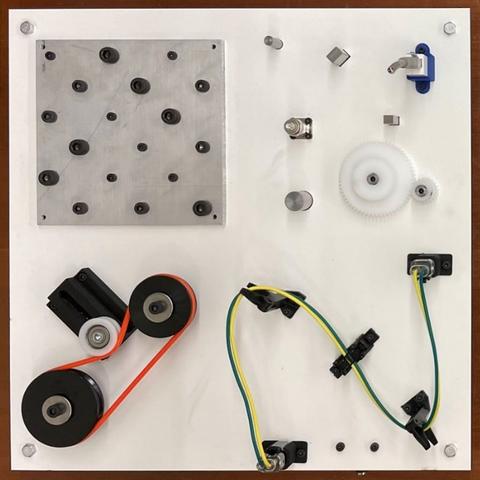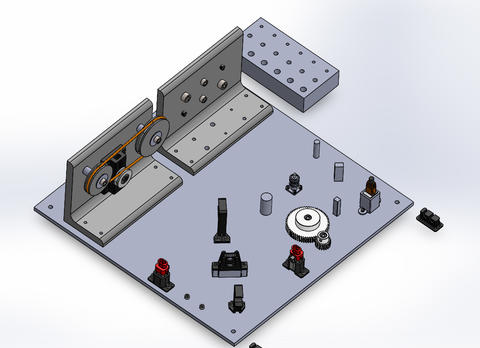IROS 2022 Robotic Grasping and Manipulation Competition: Manufacturing Track
There will be two manufacturing sub-tasks in the competition, Assembly and Disassembly of a NIST Task Board (NTB). The task board used for ICRA will be used as the practice task board for IROS 2022 (See: https://www.nist.gov/el/intelligent-systems-division-73500/icra-2022-robotic-grasping-and-manipulation-competition). For teams that are joining without having competed in ICRA, the pre-competition design will be made available leading up to the competition. A new competition board with modified assembly positions (very similar to the pre-competition NTB), and new parts (identical to all parts used in practice), will be supplied just prior to a team’s scheduled competition run on their competition day. This competition board will be similar to the practice board however, some threaded fastener operations and the belt drive will be located on vertical surfaces. Teams should modify practice board to include similar configurations.
Teams must apply to compete in this competition. Teams who did not compete in the ICRA 22 RGMC competition must also send a one to two-page text description of the robotic assembly system that you will use to compete by July 22, 2022 to Yu Sun (yusun [at] mail.usf.edu (yusun[at]mail[dot]usf[dot]edu)). Include descriptions of your autonomous assembly strategies and robotic assembly system; robot manipulators, end effector technology, sensors used for perception, control software and any plans for incorporating the use of supplied CAD data. Solutions that rely primarily on teaching (also called lead through programming) are not recommended. Images and Videos that help describe your system and operating principles are encouraged, but not required. Also include shipping information for sending NTBs in the case that your team is selected as follows:
Company/Organization:
*Attention:
Address:
Country/Territory:
Postal Code:
City or Town:
State/Province/County:
Telephone:
E-mail Address:
* It’s very important that a person’s name is included in the Attention field.
Note: The organizers cannot guarantee the shipping times of the NTBs. Therefore, we have also included all sources and instructions for producing the practice board (pre-competition NTB) on the manufacturing track web site.
The IROS 2022 manufacturing track will accommodate teams that are interested in participating in a remote format. A separate competition day will be held for this format on the week before the IROS 2022 in-person competition.
Competition Design:
The goal of the competition is to test the capabilities of a robot system in performing assembly operations relative to a small-parts manufacturing process using assembly task boards. The task board for this competition was designed based on similar task boards that have been developed as part of a NIST project to support the advancement of robotic systems for variable small-batch production runs in future manufacturing systems (see: https://www.nist.gov/el/intelligent-systems-division-73500/robotic-grasping-and-manipulation-assembly/assembly).
Competition parts have been selected to replicate typical manufacturing assembly operations. Competing robot systems should recognize, grasp, and assemble/disassemble various parts including flexible ones, and assemble/disassemble a new product by quickly reconfiguring the system. The limited competition time and bonus applied remaining time should encourage autonomous system designs where the use of perception (machine vision and force sensing) will eliminate the time associated with teaching (also called lead through programming) and the need for jigs (also called fixturing). The principles of design & manufacture make part data readily available to the automated systems in the form of Computer-Aided Design (CAD) data. Therefore, all CAD models will be made available to competitors in the form of SOLIDWORKS part and assembly files.
The manufacturing track of the IROS 2022 Robotic Grasping and Manipulation Competition will consist of two subtasks; an assembly subtask, and a disassembly subtask both using the NTB. Figure 1 shows the design to be used for the pre-competition NTB. Figure 2 shows the concept for how the NTB will be modified for competition day. Many of the components used are the same as those previously used on the 2019 and 2020 competitions. When the competition task board is removed from a sealed box at the start of the competition run, an example kit layout is also provided to present parts for the assembly subtask. During the competition the location of the parts on the task board and the kit will change.
- Preliminary rules and scoring for the competition (subject to change)
- Instructions to Produce an IROS 2022 Manufacturing Track Practice Task Board
- Kit files
- SOLIDWORKS Computer Aided Design (CAD) files
- Stereolithography (STL) files
- Miscellaneous files
- Demonstration video of task board assembly:
Video of NTB assembled and disassembled by human
In a remote format, each team’s competition run will be recorded by teams in their respective robot laboratory and viewed live using video conferencing by a remote judge. Each team is responsible for video recording their entire competition period and must send this video to the competition organizer. The locations of the task board and kit must be randomly defined using Velcro attachment points and tape at the start of the competition under the supervision of the remote judge. Random board placement and part position changes are used to highly encourage the use of autonomous system designs. More detail is provided in the rules document below.
Teams must also submit a video of their robot system performing the tasks on either the practice or competition NTB with written or verbal description of how their system works. This video should be submitted by the end of the competition week. This is a chance for teams to show their best performance on their system. Teams are encouraged to include details on what tasks were difficult and how they might improve.

|

|

